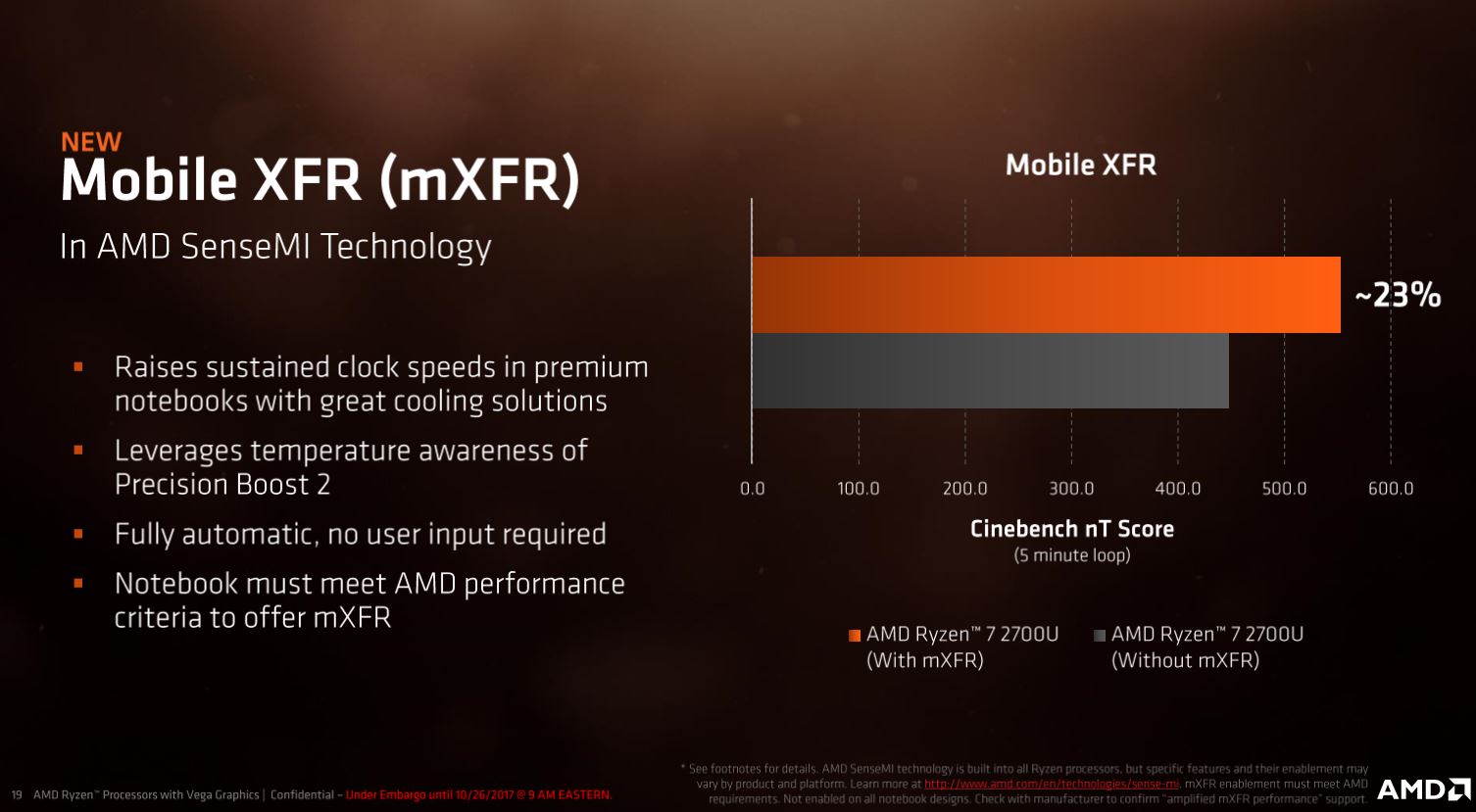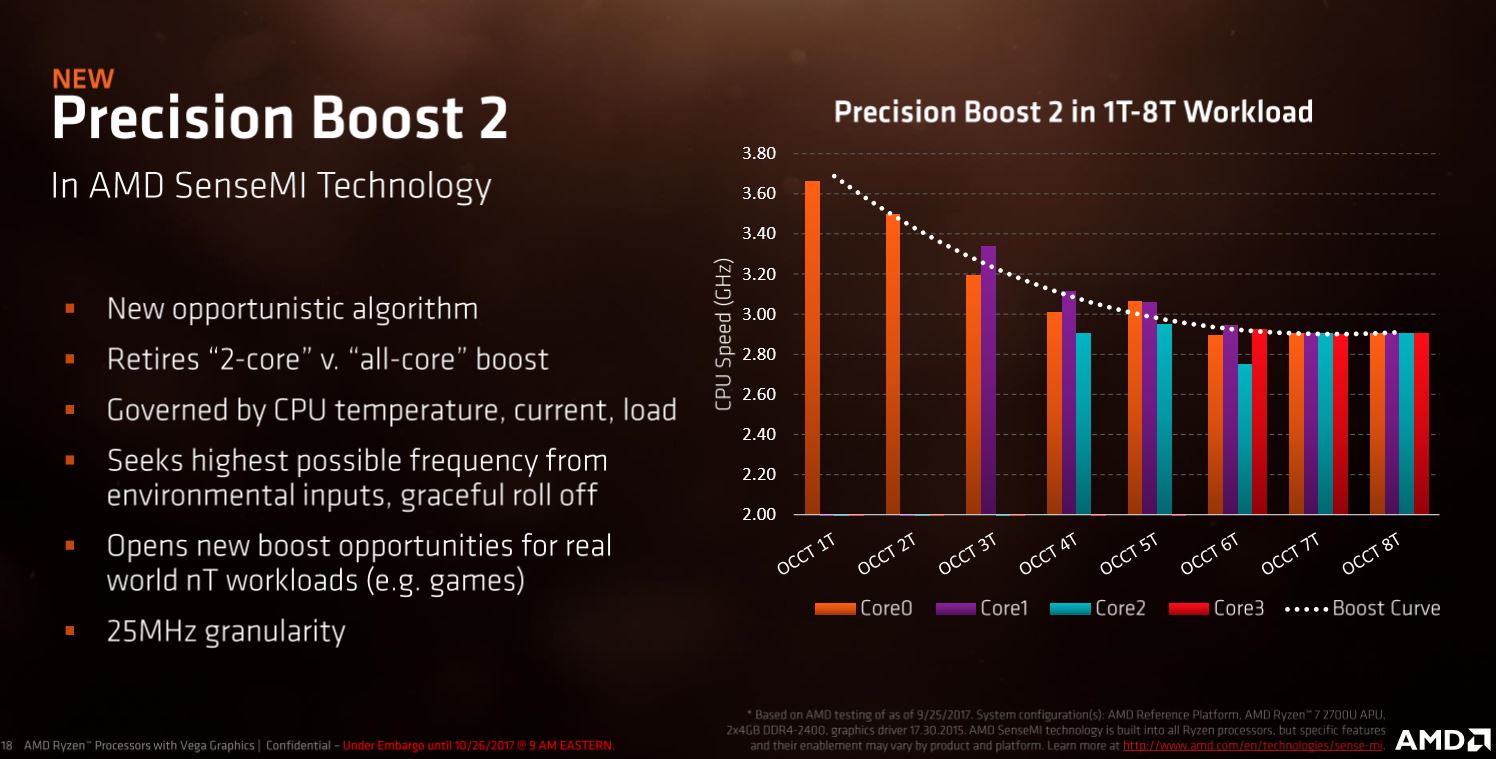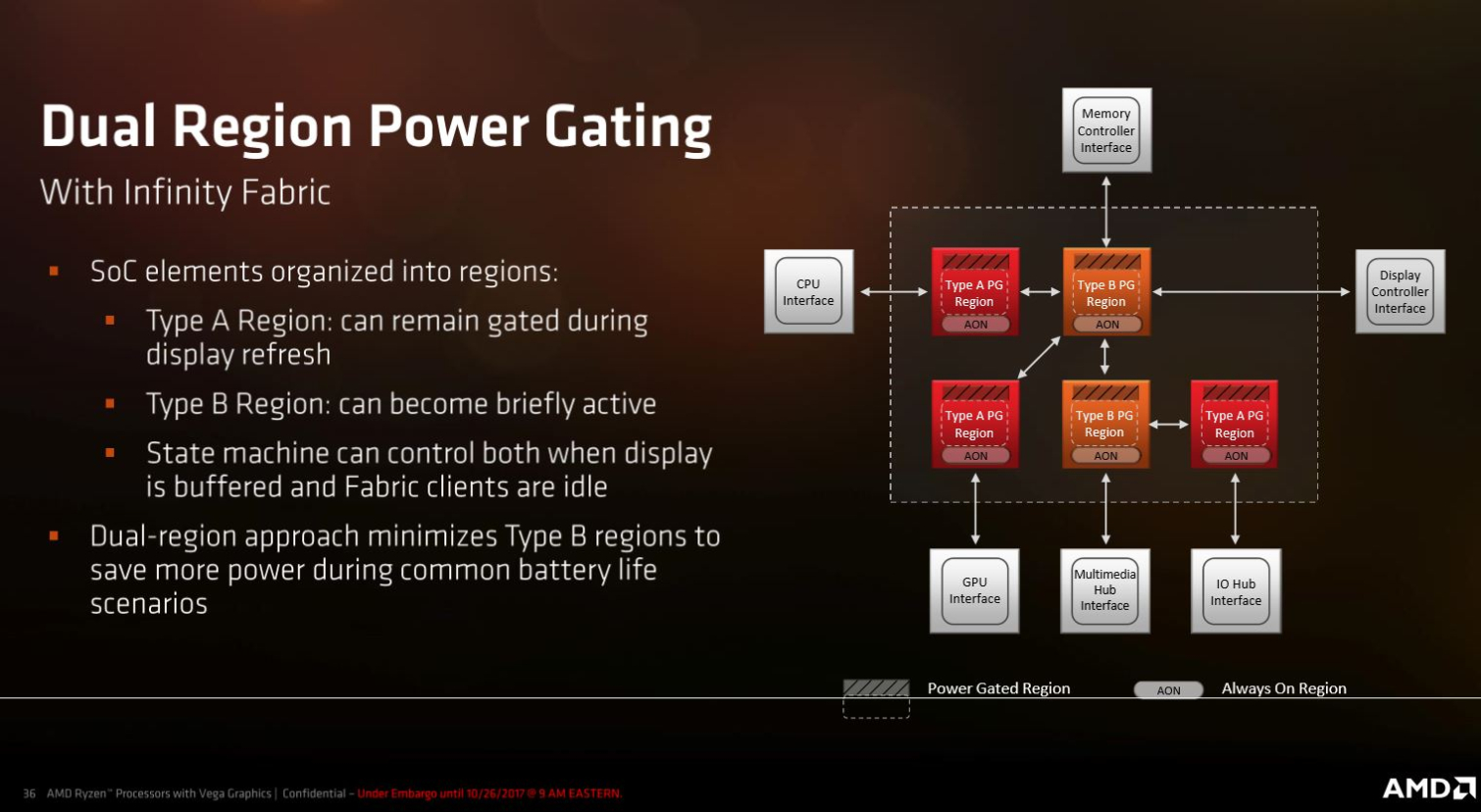AMD Launches Ryzen Mobile Processors
AMD announced that its Ryzen Mobile processors, the APUs formerly known as Raven Ridge, will be available in laptops from leading OEMs in time for the holiday season. The processors feature Zen compute cores paired with Radeon "Vega" graphics cores in an SoC (System on a Chip) design.
AMD's Zen microarchitecture has truly had a transformative impact on the desktop PC industry. The bedrock Zen design, paired with the Infinity Fabric interconnect, provided enough performance for AMD to rise back into contention with Intel. This year alone, AMD has released a string of Zen-based Ryzen desktop products to satisfy nearly every pricing niche. Now it's time for AMD to tackle the mobile market.
AMD has a key advantage over its rival Intel, though--it's the only company that produces both x86 processors and GPUs. The company unveiled its new Radeon RX Vega graphics cards earlier this year, and now the company is tying the graphics cores and Zen microarchitecture together with the Infinity Fabric.
According to AMD, the pairing provides explosive performance gains of 44% more multi-threaded CPU performance and 161% more graphics performance than Intel's new Kaby Lake Refresh mobile processors.
The Ryzen Mobile Die
The Ryzen mobile processors debut with two SKUs. The "U" suffix denotes that the Ryzen 7 2700U and 2500U are destined for ultralights, but processors optimized for different devices will come to market over the next year. AMD hasn't said when the Zen+Vega PIB (Product In Box) APUs, which you'll be able to buy at retail, will arrive.
Both Ryzen APUs feature four cores and eight threads, but in a big departure from the previous Ryzen models, they only feature a single Core Complex (CCX).
Moving to a single CCX instead of the dual-CCX design currently found in the Ryzen desktop processors is a critical step. The design ensures that the Ryzen Mobile processors can slip in under the size, power, and thermal constraints of mobile products. We can spot the four-core CCX to the left of the die shot above. The Vega graphics cores populate the right side of the die.
Get Tom's Hardware's best news and in-depth reviews, straight to your inbox.
Speeds And Feeds
Both 15W Ryzen Mobile processors feature four Zen cores and eight threads fed by 4MB of L3 cache. The design employs the same 14nm Global Foundries FinFET process as the Ryzen desktop models. The processors feature a dual-channel memory controller that supports up to DDR4-2400, but it is noteworthy that some OEM designs will only feature a single memory channel. That can reduce graphics performance significantly.
The Ryzen 7 2700U slots in as the high-performance model with a 2.2GHz base and 3.8GHz Precision Boost frequency. The slightly lesser Ryzen 5 2500U model comes with a 2.0GHz base and 3.6GHz boost.
| Row 0 - Cell 0 | AMD Ryzen 7 2700U | Intel Core i7-8550U | AMD Ryzen 5 2500U |
| Cores / Threads | 4 / 8 | 4 / 8 | 4 / 8 |
| TDP | 12 - 25W, 15W Nominal | 10 - 25W, 15W Nominal | 12 - 25W, 15W Nominal |
| Base Frequency (GHz) | 2.2 | 1.8 | 2.0 |
| Boost Frequency (GHz) | 3.8 | 1 Core: 4.0, 2 Core: 4.0, 4 Core: 3.7 | 3.6 |
| Graphics | 10 Radeon Vega CUs | UHD Graphics 620 | 8 Radeon Vega CUs |
| Graphics Base / Boost | Up to 1,300MHz | 300MHz / 1.15GHz | Up to 1,100MHz |
| L3 Cache | 4MB | 8MB | 4MB |
| Memory Controller | Dual Channel | Dual Channel | Dual Channel |
| Memory Speed Support | DDR4-2400 | DDR4-2400 / LPDDR3-2133 | DDR4-2400 |
| Process | 14nm GloFo FinFET | 14nm++ | 14nm GloFo FinFET |
| CPU Architecture | Zen | Kaby Lake Refresh | Zen |
The Ryzen 7 2700U features ten Radeon Vega CUs (Compute Units) while the 2500U steps down to eight CUs. The beefier 2700U features a higher 1,300MHz maximum graphics boost frequency, while the 2500U tops out at 1,100MHz.
AMD hasn't provided pricing for the new models, but based on AMD's performance comparisons, we know they contend with the Kaby Lake Refresh Core i7-8500U. Like the Ryzen Mobile processors, Intel's 15W processor features four cores and eight threads, but it has a significantly lower base frequency. However, the -8550U compensates with higher multi-core turbo frequencies. AMD has also transitioned to a more sophisticated multi-core boosting implementation, a first for a Zen-based processor, which we'll cover shortly.
A Note on Configurable TDP's
Like the Ryzen models, the Intel i7-8500U features a configurable TDP range instead of a static specification. This allows OEMs to tailor mobile products with lower TDP (cTDP-down) settings for increased battery life, or higher settings (cTDP-up) that trade battery life for more performance.
AMD and Intel's TDP settings allow vendors to cram powerful processors into thinner and lighter devices by easing the thermal dissipation requirements. Unfortunately, this permanent setting lowers performance significantly, and OEMs aren't required to disclose the TDP configuration. Many do this with little fanfare. The end user cannot adjust the statically-assigned TDP value.
Intel's processors also support Dynamic TDP, which allows the device to make on-the-fly cTDP adjustments based on sensor feedback, such as device orientation or internal and external temperature sensors. Dynamic cTDP adjustments allow throttling when the device is hot, such as outside on a sunny day or after extended heavy workloads, to keep the chip within a safe thermal envelope.
AMD hasn't said if it supports a Dynamic TDP feature. Intel's TDP settings may have an impact on AMD's performance measurements below. For instance, Intel's cTDP downshifts the processor to an 800MHz clock rate, which of course drastically reduces performance.
AMD's Performance Comparisons
AMD used an Acer Spin 5 with the Core i7-8500U processor for many of the performance comparisons. The Spin 5 is a thin convertible that doesn't have much bulk for thermal dissipation, which means Acer could have set a lower 10W setting to accommodate the form factor. We reached out to Acer for confirmation, but have yet to receive a response. Also, a dynamic TDP configuration could throttle the processor below the 15W threshold during extended heavy testing.
AMD verified that it tested the Ryzen processors with a 15W TDP setting, but the test notes for the Cinebench tests indicate AMD tested the Ryzen 7 2700U on a reference motherboard. We've included the test notes at the end of the article.
In either case, the 4C/8T Ryzen 7 2700U offers a whopping 36% more performance than the 4C/8T eight-generation Core i7 during the Multi-Threaded test. Ryzen's Multi-Threaded lead is even more pronounced against Intel's seventh-generation 2C/4T Core i5-7500U. The Core i7-8500U wins during a Cinebench single-threaded test, which is expected given the characteristics of the Kaby Lake architecture.
The 3DMark Timespy test is overwhelmingly in AMD's favor, and the Ryzen 7 2700U even beats the Core i7-7500U paired with a GeForce 950M. AMD tested the Ryzen 7 2700U on an AMD Reference Platform with integrated Vega graphics. It's notable that a portion of the Time Spy scoring is dedicated to CPU physics tests, so CPU performance plays a big role.








For perspective, AMD also provided a test that shows the 15W AMD Ryzen 7 2700U providing a higher multi-threaded Cinebench score than the 91W desktop Core i5-7600K. The Ryzen results were captured on an AMD Reference Platform while the Core i5-7600K was paired with an MSI motherboard. That's an incredible result. AMD's processor features eight threads, while Intel's i5-7600K only features four, which contributes to the performance advantage.
AMD's spider chart, derived from the company's internal test data, shows the Ryzen 7 2700U beating Intel's Core i7-8550U in five of six categories. AMD lists I/O performance is the sole winning category for Intel. AMD generated these results with the Core i5-7500U in the Acer Spin 5 and the Ryzen 7 2700U on the company's reference platform.
AMD also provided a range of productivity test results that highlight solid performance gains over Intel in a wide range of common applications. The company also included application launch speed testing compared to its older FX-9800P processor. Finally, we see average FPS measurements for the Ryzen 7 2700U in an HP ENVY X360. The benchmarks consist of 1920x1080 gaming in League of Legends, DOTA 2, and CS:GO. The company also tested Overwatch and Quake Champions at 1280x720. None of these titles are particularly graphics-intensive, but delivering playable frame rates within a 15W envelope is encouraging.
Precision Boost 2 & Mobile eXtended Frequency Range (mXFR)
AMD's SenseMI suite consists of five technologies that allow Ryzen processors to adjust performance and power consumption parameters in real time. AMD has improved the suite and baked in performance-boosting additives. Much like AMD's XFR for the desktop, the new Mobile eXtended Frequency Range (mXFR) feature allows the processor to dynamically adjust its clock rate above the stock and Precision Boost frequency based on available thermal headroom.
The mXFR boost requires a robust cooling solution, such as those found in premium notebooks. Select high-end notebooks certified for "Ultimate XFR Performance" will offer up to 23% more performance during multi-threaded workloads.



AMD's Precision Boost feature, which debuted with the Ryzen desktop models, is similar to Intel's Turbo Boost. However, AMD's mainstream desktop processors only provided dual-core and all-core boost frequencies.
AMD's new Precision Boost 2 algorithms include a more sophisticated set of boost frequencies that operate based on varying numbers of active threads. The feature now scales from one to eight active threads, but AMD has not provided a complete listing of the multi-core turbo frequencies.
AMD also said it is bringing Precision Boost 2 to its future desktop processors, but didn't provide a timeline.
Power Enhancements
As with any product destined for mobile applications, power consumption is key. AMD's Infinity Fabric ties the Zen and Vega cores together and provides the communication backbone for fine-grained telemetry data. That allows the processor to react to temperature, current, and voltage changes.
The Ryzen Mobile processors have several layers of elements, such as CPU and graphics cores, which it can shut off independently to save power. The power-gated areas also extend to the entire chip. The SoC also uses both internal and external (on the motherboard) voltage regulators that communicate with each other but operate independently, thus allowing the processor to deactivate a regulator when it isn't needed. That drops the processor into a lower power state.






Intel's Kaby Lake and AMD's Bristol Ridge processors feature two power rails, one dedicated to the CPU and another dedicated to the GPU. The Ryzen Mobile processors use a single rail for both regions to enable power sharing. That allows the SoC to dedicate more current to regions that are experiencing heavier load, which boosts performance.
The "Per-core Frequency and Voltage" slide outlines AMD's ability to manipulate each CPU core's clock speed independently. That's more sophisticated than the desktop processor, which can only control frequencies at the CCX level (groups of four cores).
Shutting off areas of the chip, called power gating, requires a fast resumption time (gate exit). Simply put, if you put a core to sleep you want it to quickly resume activity when called upon. AMD provided performance data that highlights the faster gate exit times relative to the previous generation FX-9800P. AMD designed the faster resumption times to allow power gating without drastically impacting the user experience.
AMD claims the collective improvements provide a 2X improvement in battery life compared to the previous-generation FX-9800P.
Thoughts
The arrival of the Ryzen Mobile processors signals another big step forward for AMD. The company currently has a single-digit market share in the mobile space, which typically ships more units than the desktop PC market. That represents a tremendous growth opportunity. Provided AMD's Ryzen Mobile processors live up to the claims, the company is sure to make headway.
On the desktop side, AMD's Ryzen processors have proven to be wildly successful, but the lack of integrated graphics has hindered their addressable market. For now, Ryzen processors are confined to systems with discrete GPUs, which is roughly only 30% of the desktop market. The arrival of a Zen and Vega combination is only coming to notebooks for now, but it foreshadows the pending arrival of APUs on the desktop. That'll give AMD a broader appeal, particularly on the low end of the market.
Test Notes

Paul Alcorn is the Editor-in-Chief for Tom's Hardware US. He also writes news and reviews on CPUs, storage, and enterprise hardware.
-
samer.forums I was expecting 8 cores for notebooks from Ryzen... lets hope they release a 45watt 8 cores Ryzen mobile APU.Reply
Lets hope that they include a better GPU as well for the GTX 950 mobile is VERY SLOW by today standards.
-
hannibal Most likely faster versions have separate gpu not bigger impedded gpu...Reply
But very good upgrade and addition to Ryzen family!
We just have to hope that manufacturers will bring these to different sized and different prise sector too. -
AnimeMania Reply20310843 said:I was expecting 8 cores for notebooks from Ryzen... lets hope they release a 45watt 8 cores Ryzen mobile APU.
Lets hope that they include a better GPU as well for the GTX 950 mobile is VERY SLOW by today standards.
This has a fast processsor and a slow GPU (as far as gaming is concerned). Laptops based on this chip would be excellent candidates for one of those external GPU boxes. -
Wisecracker The Bristol Ridge 'Cat' mobiles (and the Carizzo's, too) were quite frisky, great with power use, and relatively easy to mod with SSDs. Should be some great bargains popping-up in the next few weeks with AMD RyZen laptops coming to market.Reply
AMD is on a roll -- hopefully OEMs will pump-out some quality builds ...
-
acosta.87 Reply20310843 said:I was expecting 8 cores for notebooks from Ryzen... lets hope they release a 45watt 8 cores Ryzen mobile APU.
Lets hope that they include a better GPU as well for the GTX 950 mobile is VERY SLOW by today standards.
Very unlikely considering they integrated hbm and need to adhere to a rather conservative TDP. Having 8 cores would require a robust cooling solution. A six core offering seems much more feasible but that's nowhere to be seen in the slides shown so far. -
TJ Hooker Reply
Where have you seen that Raven Ridge has integrated HBM?20311966 said:20310843 said:I was expecting 8 cores for notebooks from Ryzen... lets hope they release a 45watt 8 cores Ryzen mobile APU.
Lets hope that they include a better GPU as well for the GTX 950 mobile is VERY SLOW by today standards.
Very unlikely considering they integrated hbm and need to adhere to a rather conservative TDP. Having 8 cores would require a robust cooling solution. -
technoholic These are APUs, i'm more interested in hearing from the mobile CPU side. If they can do this kind of apu thing in a so little power envelope, i'm hopeful for a good mobile all-cpu design from themReply



